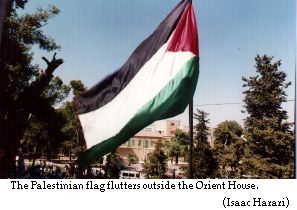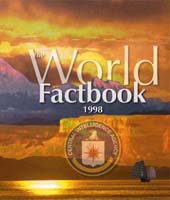|
Geography
Location: Middle East, west of Jordan Geographic
coordinates: 32 00 N, 35 15 E
Area: total: 5,860 sq km land: 5,640 sq km
water: 220 sq km note: includes West Bank, Latrun Salient, and
the northwest quarter of the Dead Sea, but excludes Mt. Scopus;
East Jerusalem and Jerusalem No Man's Land are also included
only as a means of depicting the entire area occupied by Israel
in 1967
Area-comparative: slightly smaller than Delaware
Land boundaries: total: 404 km border countries: Israel 307 km,
Jordan 97 km
Coastline: 0 km (landlocked) Maritime claims: none (landlocked)
Climate: temperate, temperature and precipitation
vary with altitude, warm to hot summers, cool to mild winters
Terrain: mostly rugged dissected upland, some vegetation in west,
but barren in east
Elevation extremes: lowest point: Dead Sea -408 m highest point:
Tall Asur 1,022 m
Natural resources: NEGL
Land use: arable land: 27% permanent crops:
0% permanent pastures: 32% forests and woodland: 1% other: 40%
Irrigated land: NA sq km Natural hazards: NA Environment-current
issues: adequacy of fresh water supply; sewage treatment
Environment-international agreements: party to: none of the selected
agreements signed, but not ratified: none of the selected agreements
Geography-note: landlocked; highlands are main recharge area
for Israel's coastal aquifers; there are 207 Israeli settlements
and civilian land use sites in the West Bank and 29 in East Jerusalem
(August 1997 est.)
People
Population: 1,556,919 (July 1998 est.) note:
in addition, there are 155,000 Israeli settlers in the West Bank
and 164,000 in East Jerusalem (August 1997 est.)
Age structure: 0-14 years: 45% (male 359,848;
female 342,173) 15-64 years: 52% (male 405,929; female 396,928)
65 years and over: 3% (male 21,853; female 30,188) (July 1998
est.)
Population growth rate: 3.71% (1998 est.)
Birth rate: 36.65 births/1,000 population (1998 est.) Death rate:
4.35 deaths/1,000 population (1998 est.) Net migration rate:
4.82 migrant(s)/1,000 population (1998 est.)
Infant mortality rate: 26.35 deaths/1,000
live births (1998 est.) Life expectancy at birth: total population:
72.47 years male: 70.7 years female: 74.33 years (1998 est.)
Ethnic groups: Palestinian Arab and other
83%, Jewish 17%
Religions: Muslim 75% (predominantly Sunni), Jewish 17%, Christian
and other 8%
Languages: Arabic, Hebrew (spoken by Israeli settlers and many
Palestinians), English (widely understood)
Literacy: NA
Economy
Economic progress in the West Bank has been
hampered by tight Israeli security restrictions. Industries using
advanced technology or requiring sizable investment have been
discouraged by a lack of local capital and Israeli policies that
block the movement of goods and people. Capital investment consists
largely of residential housing, not productive assets that would
enable local Palestinian firms to compete with Israeli industry.
GDP has been substantially supplemented by workers who commute
to jobs in Israel. Worker remittances from the Persian Gulf states
dropped after Iraq invaded Kuwait in August 1990. In the wake
of the Persian Gulf crisis, many Palestinians have returned to
the West Bank, increasing unemployment, and export revenues have
dropped because of the decline of markets in Jordan and the Gulf
states. An estimated 147,000 people were in refugee camps in
1996.
GDP: purchasing power parity-$2.8 billion
(1996 est.) GDP-real growth rate: -6.9% (1996 est.) GDP-per capita:
purchasing power parity-$1,600 (1996 est.) GDP-composition by
sector: agriculture: 33% industry: 25% services: 42% (1995 est.,
includes Gaza Strip)
Inflation rate-consumer price index: 8.4%
(1996 est.)
Budget: revenues: $684 million expenditures: $779 million, including
capital expenditures of $NA (1996) note: includes Gaza Strip
Labor force: NA by occupation: agriculture
13%, industry 13%, commerce, restaurants, and hotels 12%, construction
8%, other services 54% (1996) note: excluding Israeli settlers
Unemployment rate: 28% (1997 est.)
Industries: generally small family businesses
that produce cement, textiles, soap, olive-wood carvings, and
mother-of-pearl souvenirs; the Israelis have established some
small-scale, modern industries in the settlements and industrial
centers

Industrial production growth rate: NA%
Electricity-capacity: NA kW note: most electricity
imported from Israel; East Jerusalem Electric Company buys and
distributes electricity to Palestinians in East Jerusalem and
its concession in the West Bank; the Israel Electric Company
directly supplies electricity to most Jewish residents and military
facilities; at the same time, some Palestinian municipalities,
such as Nabulus and Janin, generate their own electricity from
small power plants
Agriculture-products: olives, citrus and other
fruits, vegetables; beef, dairy products
Exports: total value: $630 million (f.o.b.,
1997 est.) (includes Gaza Strip) commodities: olives, fruit,
vegetables, limestone partners: Jordan, Israel
Imports: total value: $1.7 billion (c.i.f., 1997 est.) (includes
Gaza Strip) commodities: food, consumer goods, construction materials
partners: Jordan, Israel
Debt-external: $51 million (1995)
Economic aid: recipient: ODA, $NA
Currency: 1 new Israeli shekel (NIS) = 100
new agorot; 1 Jordanian dinar (JD) = 1,000 fils
Communications
Telephones: NA note: 3.1% of Palestinian households
have telephones
Telephone system: domestic: NA international: NA note: Israeli
company BEZEK and the Palestinian company PALTEL are responsible
for communication services in the West Bank
Radio broadcast stations: AM 1, FM 0, shortwave
0 Radios: NA; note-82% of Palestinian households have radios
(1992 est.) Television broadcast stations: about 25 low-powered
stations Televisions: NA; note-54% of Palestinian households
have televisions (1992 est.)
Transportation
Railways: 0 km Highways: total: 4,500 km paved:
2,700 km unpaved: 1,800 km (1997 est.) note: Israelis have developed
many highways to service Jewish settlements
Ports and harbors: none Airports: 2 (1997
est.) Airports-with paved runways: total: 2 1,524 to 2,437 m:
1 under 914 m: 1 (1997 est.)
Transnational Issues
Disputes-international: West Bank and Gaza Strip are Israeli-occupied with
current status subject to the Israeli-Palestinian Interim Agreement-permanent
status to be determined through further negotiation
|


